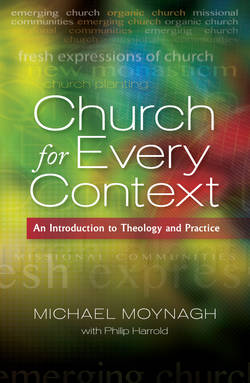Читать книгу Church for Every Context - Michael Moynagh - Страница 107
На сайте Литреса книга снята с продажи.
Оглавление5
What is the Purpose and Nature of the Church?
One of the first questions often asked about new contextual churches is whether they are truly church. Indeed, many of the concerns about these communities arise from calling them church. In offering a theological rationale for these churches, therefore, Part 2 starts with a discussion about the nature of the church. It then considers the place of mission in church, the communal nature of mission in the local church, the extent to which new churches should be contextualized, whether it is legitimate for these churches to focus on a specific cultural group and whether new contextual churches are faithful to the tradition. These chapters draw on, and are intended to contribute to ongoing reflection – still at an early stage – about new contextual churches.
Whereas the traditional approach to evangelism begins with the current church and asks how people can be encouraged to belong, new contextual churches go to where people are and ask what church should appropriately look like in their context. Many young adults think that this is common sense. Meeting with friends to form a new Christian community in everyday life and calling it church seems an obvious thing to do.
It makes all sorts of people nervous, however. Are we playing fast and loose with the language, using ‘church’ when it does not really apply? Are we taking seriously what mature church entails? Others wonder if all this talk about church risks putting a straitjacket on mission, encouraging practitioners to worry more about being church than about being contextual. This chapter considers the purpose of church, asks what constitutes the essence of the church and discusses what mature church involves.
What is the purpose of the church?
As God’s visible people, the church has its purpose in relation to the kingdom of God, which was a central theme in Jesus’ ministry. In Luke 4.17–9, for instance, Jesus identified himself with Isaiah’s vision of the kingdom. The vision included peace for the entire earth (Isa. 2.4), light where there has been darkness (9.2), harmony in the whole of creation (11.6) and a world of health, justice and abundance (65.17–24). Jesus taught the values of the kingdom, challenged the assumptions of his society from a kingdom perspective and demonstrated the power of the kingdom through his miracles. His life, death and resurrection inaugurated the kingdom, which will be established in full when he returns. In the ‘between time’ church bears witness to the kingdom. But what does bearing witness involve?
Church-shaped kingdom?
There is a spectrum in how theologians understand the relationship between church and kingdom. At one end are those who say the church is where the kingdom is made real in the present (Higton, 2008, p. 335). This ‘church-shaped kingdom’ view was assumed in the church-centred approach to mission common in the nineteenth and early twentieth centuries. In the mid nineteenth century, Henry Venn and others in the Anglo-Saxon tradition argued that church planting should be considered a goal of missionary endeavours, alongside personal conversion. Mission came to be seen as church extension overseas (Scherer, 1993, pp. 82–4). The kingdom of God was not discussed in connection with church and mission till the 1930s.
J. C. Hoekendijk, whose solution was not without problems, summarized the prevailing view in 1952:
The world has almost ceased to be the world and is now conceived of as a sort of ecclesiastical training-ground. The kingdom is either confined within the bounds of the Church or else it has become something like an eschatological lightning on the far horizon. (1952, p. 324)
Although theologians have brought the relationship between church and kingdom more sharply into focus since World War Two, the assumption that mission was mainly about church left a legacy. Many Christians today still define the world in church categories, distinguishing – in Hoekendijk’s words – ‘not-yet-church, already-church, still-church and no-longer church’ (1952, p. 324). They see mission primarily in terms of evangelism, of working with God to draw people into his family. The church follows the Spirit into the world to rescue it from sin and bring people into the kingdom. Individuals enter the kingdom when they are born again and become members of the church. Church and kingdom are virtually collapsed into one.
On this view, through the Spirit the church imperfectly embodies the kingdom in its life, not least by explicitly acknowledging the Lord’s reign. In some perspectives the kingdom is spiritualized – by entering the church you enter a spiritual kingdom. But increasingly the kingdom is seen in physical terms, as God’s rescue of the whole of creation. The church then becomes God’s agent and foretaste of a holistic kingdom. It joins the Spirit in pushing back forces that threaten creation’s well-being, and conversion includes being converted to this task. The underlying assumption, however, remains the same: the church is the gateway to and the vehicle of the kingdom.
Is this the perspective of Mission-shaped Church (2004), which kick-started fresh expressions of church in the UK? John Hull lambasts the report for leaning too heavily in this direction. The lineage of church planting, in which mission was closely identified with church extension, encouraged the working party to become too church centred in its theology. ‘We looked for a mission-shaped church but what we found was a church-shaped mission’ (Hull, 2006
